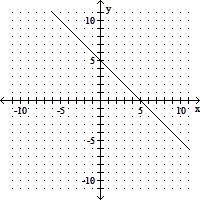Consider the differential equation. A detailed direction field is not needed. Find the solutions that are constant, for all  (the equilibrium solutions). In what regions are solutions increasing? Decreasing?y'(t) = (y - 3)(y + 9)
(the equilibrium solutions). In what regions are solutions increasing? Decreasing?y'(t) = (y - 3)(y + 9)
A. y = 3, y = -9; increasing for -9 < y < 3; decreasing for y < -9 or y > 3
B. y = -3, y = 9; increasing for -9 < y < 3; decreasing for y < -9 or y > 3
C. y = -3, y = 9; increasing for y < -9 or y > 3; decreasing for -9 < y < 3
D. y = 3, y = -9; increasing for y < -9 or y > 3; decreasing for -9 < y < 3
Answer: D
You might also like to view...
Write the numbers in order from smallest to largest.0.071, 0.017, 0.011, 0.077
A. 0.011, 0.077, 0.017, 0.071 B. 0.077, 0.071, 0.017, 0.011 C. 0.011, 0.071, 0.017, 0.077 D. 0.011, 0.017, 0.071, 0.077
Write the equation of the line whose graph is shown.
A. y = x + 5 B. y = - x - 5 C. y = x - 5 D. y = - x + 5
A formula is given along with the values of all but one of the variables in the formula. Find the value of the variable not given.P = 2L + 2W; L = 6, W = 5
A. 22 B. 17 C. 60 D. 11
Find the exact value of the expression if ? = 30°. Do not use a calculator.f(?) = sin ?Find f(?).
A. 
B. 
C. 
D. 